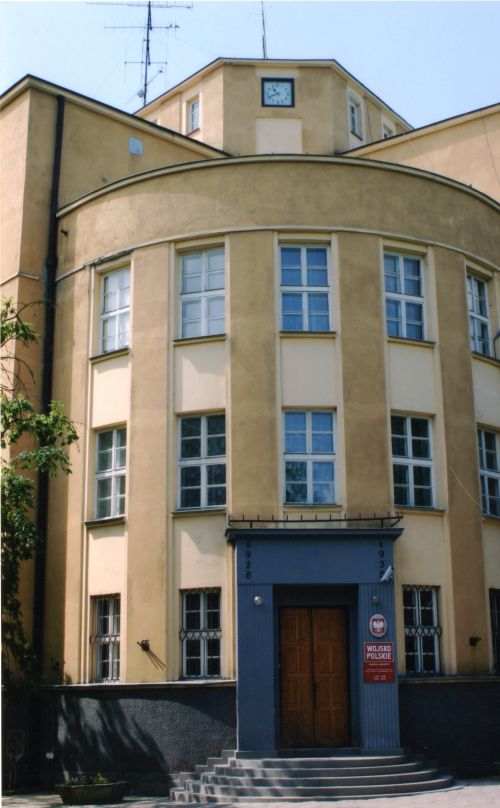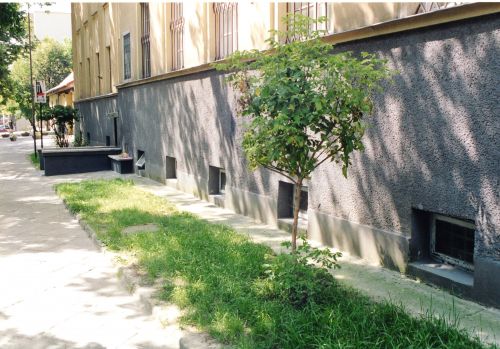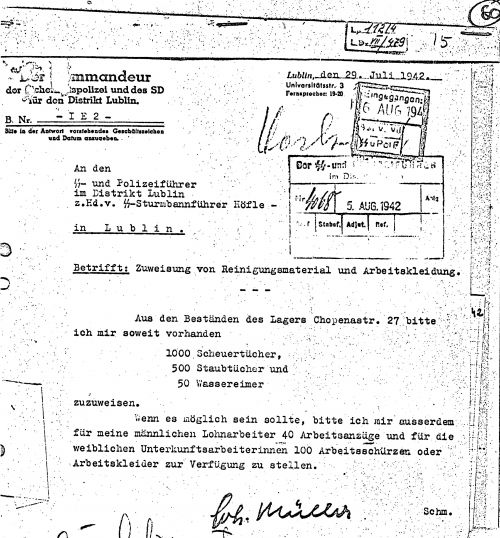Lublin - Under the Clock

Lublin Former Gestapo Headquarters 2004 (Chris Webb Private Archive)
The building at the Uniwersytecka Street in Lublin with a clock above its entrance was built between 1928, and 1930, as the seat of the Land Proprietors Office. The presence of the clock has earned it the nickname 'Under the Clock' that was commonly used during the German occupation. Before the war this three -storey building was equipped in a modern way and provided jobs for 150 full-time white-collar and about 100 seasonal workers.
When it was taken over by the Gestapo, in 1940, its interior was rebuilt to adjust it the goals and needs of the Geheime Staatspolizei. The ground floor and the upper floors were to house offices where, among others, interrogations were held. The cellars at the Uniwersytecka Street side were rebuilt as prison cells. There were 14 of them altogether, including 3 dark cells, and there was a guards room there for the guards on duty underground. Most of the cells were situated along one side one side of the corridor at the Uniwersytecka Stree. They were numbered 1-11 and D-1 (D-1 stands for Dunkelzelle -1, i.e. a dark cell). It was a very small cell, with a breadth of 75 cm. Two of the aforementioned cells were for women.
Most of the cells had the following dimensions: a length of 340 cm, a breadth of 279 cm, and a height of 238 cm. On the opposite side of the corridor, i.e. at the side of the yard, there was a large cell number 12. Another large dark cell was situated opposite cells 4 and 5. It was almost three times larger than the other dark cell situated at the Uniwersytecka Street side. Adjacent to one of the walls of the large dark cells was the smallest Dunkelzelle which was not more than a corner room in which there were water and sewage pipes. Drops of water that fell off the pipes constituted an additional form of torture for the people imprisoned there.

Lublin Former Gestapo Headquarters cells 2004 (Chris Webb Private Archive)
All the dark cells were without windows and had tightly sealed doors, while in other cells, doors were removed and replaced with crossed bars. The cells did have windows, but they were covered with wooden planks and earth. The floor had cement tiling. There was no electric light besides two bulbs in the corridor that were switched on all the time as the only source of light. All the rooms were plunged in semi darkness. Despite the existing central heating system, the cells were not heated at all. Besides the cells, in separate rooms underground there were: the 'washing room,' with a 2 meter long metal trough and toilets. This surrogate of sanitary facilities could be used only sporadically by the prisoners when they obtained permission of the guards on duty who were underground.
During the period of Poland's occupation by the Nazis, the Gestapo cells were crowded with people brought from the prison at the Castle, or directly from where they were arrested. The interrogations usually started circa 9:00 o'clock a.m. Therefore, upon their arrival, the prisoners were incarcerated in the underground cells where they waited, until being called for interrogations.
Despite thick walls, they could hear the cries of the interrogated, filled with awe, pain and suffering. The duration of their stay in the cells, 'Under the Clock,' varied from one day to several weeks of torture and suffering. Interrogations were carried out on the second and third floors by members of the Gestapo. As a result of the tortures at the interrogations, the prisoners suffered from brutal injuries. Every day, the nurse at the Castle dressed from 40 to 50 serious wounds inflicted on the prisoners by the Gestapo.
Some of the prisoners held 'Under the Clock' did not survive the interrogations. The victims bodies murdered by the Gestapo were transported to the Castle in paper bags. Being unable to state the real reason for their deaths, the doctor at the Castle stated that the cause of death were from heart weakening, throat inflammation, influenza, or other illnesses. Between 1942, and July 1944, approximately 200 bodies of prisoners tortured to death were brought in paper bags to the Castle.
Being held 'Under the Clock' was one of the stages of prisoners journey to the Castle. Those who survived the tortures at Gestapo Headquarters were incarcerated in the Castle, from where many were executed, or were sent to Concentration Camps. The Gestapo headquarters, known as 'Under the Clock' functioned until July 20, 1944, when Lublin was liberated by the Red Army.

Letter from Mueller SD Kommander SIPO und SD to Hofle
Sources
Barbara Oratowska, Under The Clock, Muzeum Lubelskie
Photographs: Chris Webb Archive
Document: Yad Vashem
© Holocaust Historical Society April 12, 2020

